Notes: Bradley Fold station was situated on the Lancashire & Yorkshire Railways (LYR) Liverpool, Bolton and Bury line. The line had been promoted by east Lancashire industrialists as the Liverpool & Bury Railway (L&BR). They wanted better access to the port of Liverpool so that they could bring in raw materials and export their goods more effectively. The L&B was authorised on 31 July1845 and work began shortly after. The L&B became part of the LYR on 9 July 1847 before the first section of the line was opened. The section of line on which Bradley Fold station was located (between Bolton and Bury Knowsley Street) was opened on 20 November 1848. On 1 May 1848 a line had opened between Bury and the LYR Manchester and Leeds railway at Castleton which provided a through route to Rochdale.
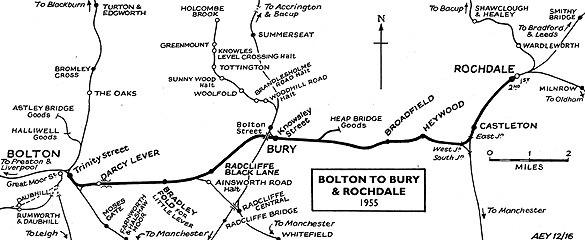 |
Bradley Fold opened with the line on 20 November 1848. It was located east of Bradley Lane which crossed the line by means of a level crossing. The line was double track and the station was provided with two platforms, both of which connected directly to the lane.
A 6-inch scale map from 1850 shows that originally the main facilities were on the up side (Bury direction).
Bradley Fold was provided with goods facilities west of Bradley Lane on the south side of the line. They consisted of two sidings, a loading platform and a 5-ton lifting crane.
To the south of the station was the Tonge Lane colliery. It was served by its own branch line which had connections to the main line going east and west. The west-facing connection was to the west of the station goods yard. The east-facing connection was at the eastern end of the passenger station.
The March 1850 timetable showed 3 trains in each direction Monday-to-Sunday.
In 1872 a signal box was opened at Bradley Fold station. It was located on the west side of the line adjacent to the level crossing on its western side. The box was a brick-built Saxby & Farmer Type 6 structure fitted with a Saxby & Farmer frame.
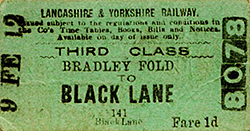 On 1 December 1879 a junction was formed 1 mile to the east of the station. Called Bradley Fold Junction it was created when the LYR opened a line from Manchester to this point via Prestwich and Radcliffe. The line had opened in stages with the section between Radcliffe South Junction and Bradley Fold Junction being the last to open (click here to read more about Bradley Fold Junction). On 1 December 1879 a junction was formed 1 mile to the east of the station. Called Bradley Fold Junction it was created when the LYR opened a line from Manchester to this point via Prestwich and Radcliffe. The line had opened in stages with the section between Radcliffe South Junction and Bradley Fold Junction being the last to open (click here to read more about Bradley Fold Junction).
From 1 December 1879 Bradley Fold started to be served by passenger trains that ran between Bolton and Manchester Victoria via the new line.
In January 1883 a down side loop was opened that stretched from the west side of Bradley Lane to Darcy Lever Colliery signal box (click here to read more about Darcy Lever Colliery Signal Box). A new frame of 23 levers was fitted to Bradley Fold signal box at this time. By 7 May 1884 an up loop had also opened between Bradley Fold and Darcy Lever Colliery Box.
By 1889 the station had been altered. The main facilities were located on the down platform (Bolton direction). They consisted of an austere single-storey brick building with rectangular windows.
On the up platform (Rochdale direction) there was a smaller building which was more attractive than its opposite number thanks to its decorated bargeboards and outsize chimneystacks.
In 1890 a wooden footbridge was erected at the western end of the station. It was designed to serve Bradley Lane pedestrians and passengers of the station. To do so it had stairways connecting to Bradley Lane on each side of the line and a connecting stairway linking to the down platform.
The December 1895 timetable showed 25 up and 30 down trains Monday-to-Friday. On Saturdays there were 2 extra up and 1 extra down services. Twelve of the trains in each direction Monday-to-Saturday ran to or from the Radcliffe line. The station was also well served on Sundays with 11 up and 12 down services.
The 1904 Handbook of Stations listed Bradley Fold as being able to handle general goods and parcels and it was equipped with a 5-ton lifting crane.
By 1906 the Tonge Lane Colliery had closed and the branch line that had served it had been lifted.
In 1907 the station signal box was replaced with an LYR Size 8 all-wood structure. The new box was in the same location as the original and it was fitted with an LYR 32-lever frame and LYR gate wheel.
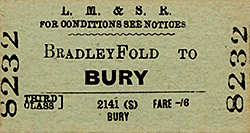 From February 1916 the direct services to Manchester Victoria ceased and in their place a rail-motor service was introduced. It ran between Bolton Trinity Street and Radcliffe. The alteration was brought about following electrification of the Bury Bolton Street to Manchester Victoria via Radcliffe and Prestwich route. A high frequency service of electric trains was operated on that line giving Bradley Fold passengers who wanted to travel via that route the option of a quick change of trains at Radcliffe. From February 1916 the direct services to Manchester Victoria ceased and in their place a rail-motor service was introduced. It ran between Bolton Trinity Street and Radcliffe. The alteration was brought about following electrification of the Bury Bolton Street to Manchester Victoria via Radcliffe and Prestwich route. A high frequency service of electric trains was operated on that line giving Bradley Fold passengers who wanted to travel via that route the option of a quick change of trains at Radcliffe.
On 1 January 1922 Bradley Fold became part of the London & North Western Railway (LNWR).
By this time two additional sidings had been laid in the goods yard.
A further change of ownership came on 1 January 1923 when the LNWR merged with other companies to become the London Midland & Scottish Railway (LMS).
During the 1930s the LMS stopped running the rail-motor on the Radcliffe services replacing it with conventional locomotives and coaches.
The LMS timetable for the summer of 1947 showed 19 trains each way on Monday-to-Friday. On Saturdays there were 19 up and 16 down services. Ten of the Monday-to-Friday up services worked to Radcliffe Central (Central being added on 11 December 1933) and 10 of the down services originated from there.
On 1 January 1948 Bradley Fold became part of British Railways (BR) London Midland Region (LMR). The BR(LMR) summer 1949 timetable showed a similar level of service to that of the LMS during its last year.
The Bolton – Radcliffe Central service was withdrawn on 21 September 1953.
In 1953 the footbridge was replaced with a concrete and steel structure; this followed the collapse of a footbridge at Bury Knowsley Street station on 19 January 1952. In the aftermath of that collapse urgent inspections were made to the other footbridges along the line and that at Bradley Fold was identified as being in need of replacement.
BR(LMR) fitted vitreous enamel nameboards and totems in the late 1950s, but did not replace gas with electric lighting.
The 1956 Handbook of Stations listed the station as being able to handle public goods and parcels. It still had its 5-ton lifting crane and there were private sidings for Dobson & Barlow’s and for Mather & Platt Ltd.
In 1960 the base of the Bradley Fold signal box was rebuilt in brick.
On 1 August 1963 Bradley Fold was closed for public goods services.
The Reshaping of British Railways (the ‘Beeching Report’) of March 1963 did not list the passenger services on the Bolton – Castleton line for withdrawal but they were in the ‘for modification’ list. On 30 October 1964 BR(LMR) proposed that passenger services between Wigan Wallgate, Bolton, Bury and Rochdale should be withdrawn, and this generated a great deal of local protest. From the start of the winter 1964 timetable Sunday services ceased to operate.
On 14 September 1966 Barbara Castle, the Minister of Transport, refused to sanction withdrawal of the passenger service between Wigan, Bolton, Bury and Rochdale and consented only to the closure of Lostock Junction station between Wigan and Bolton.
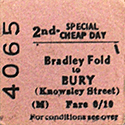 The summer 1967 timetable showed 23 up departures on Monday-to-Friday and 26 on Saturday; Sunday services operated between 18 June and 17 September only and 11 departures were provided. In the opposite direction there were 23 Monday-to-Friday departures, 28 on Saturday and 12 on Sunday. Destinations, in addition to Rochdale and Bolton Trinity Street, were Bury Bolton Street, Blackpool (North and South), Wigan Wallgate, Liverpool Exchange and Southport. The summer 1967 timetable showed 23 up departures on Monday-to-Friday and 26 on Saturday; Sunday services operated between 18 June and 17 September only and 11 departures were provided. In the opposite direction there were 23 Monday-to-Friday departures, 28 on Saturday and 12 on Sunday. Destinations, in addition to Rochdale and Bolton Trinity Street, were Bury Bolton Street, Blackpool (North and South), Wigan Wallgate, Liverpool Exchange and Southport.
On 5 November 1967 the goods loops between Bradley Fold and Bradley Fold West signal box (which had replaced Darcy Lever Colliery box in 1911) closed.
In May 1968 the Royal Train stopped at Bradley Fold station and the Queen disembarked as part of her Operation Spring Clean tour. For the visit the station was tidied up and it received a fresh coat of paint.
On 12 December 1968 BR(LMR) once again published a proposal to withdraw all passenger services from the line and again local people vigorously objected.
From 8 September 1969 Bradley Fold became an unstaffed station. On 7 May 1970 the Minister of Transport, Fred Mulley, approved the proposal to withdraw the passenger service between Bolton, Bury and Rochdale. Notice was given that all passenger services would be withdrawn with effect from 5 October 1970.
The last train to pass through Bradley Fold was the 20.07 service to Rochdale. After the train had passed, Bradley Fold signal box was closed and the line was taken out of use. Bradley Fold station closed officially with effect from 5 October 1970.
The station buildings were demolished shortly after closure but the platforms and footbridge survived until the late 1980s.
In the 1990s a footpath and cycleway was constructed through the site of the station.
Tickets from Michael Stewart and route map by Alan Young
Sources:
- A Regional History of the Railways of Great Britain - Volume 10 The North West - Geoffrey O Holt, David & Charles 1986.
- Forgotten Railways - North West England - John Marshall, David & Charles 1981.
- Lost Stations of North West England - Paul Wright, Silverlink Publishing 2011.
- The Lancashire & Rorkshire Railway, Volume 1 - John Marshall, David & Charles 1969.
- The Lancashire & Yorkshire Railway Volume 2 - John Marshall, David & Charles 1970.
Click here to see the other stations between Bolton and Castleton:
Darcy Lever, Radcliffe Black Lane,
Bury Knowsley Street, Heap Bridge Goods, Broadfield,
Heywood (2nd) and Heywood (1st)
See also: Ainsworth Road and Radcliffe |

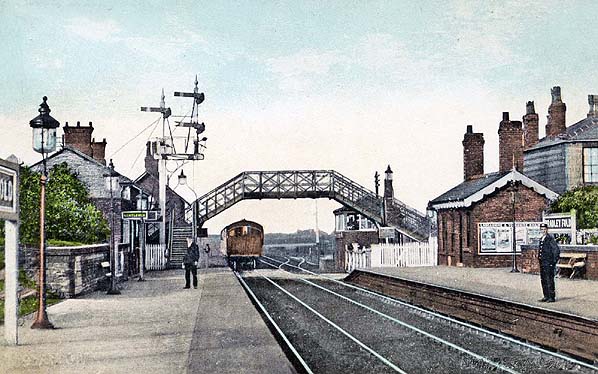
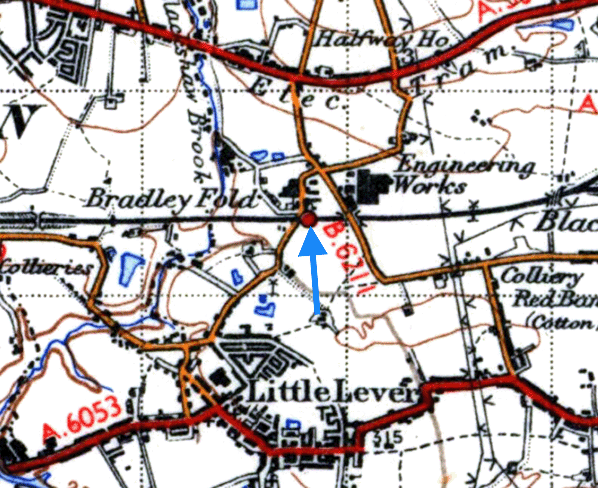
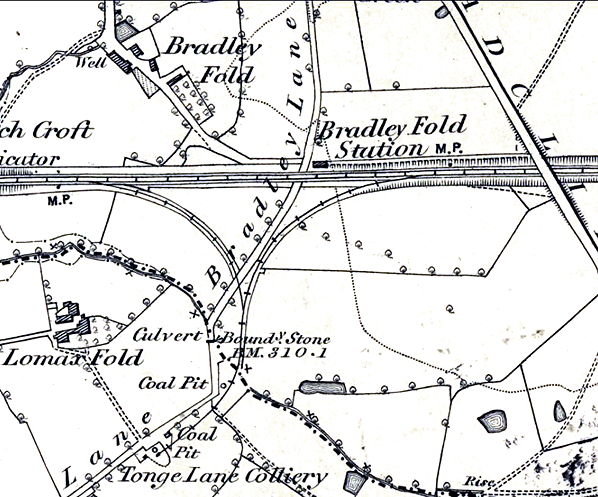
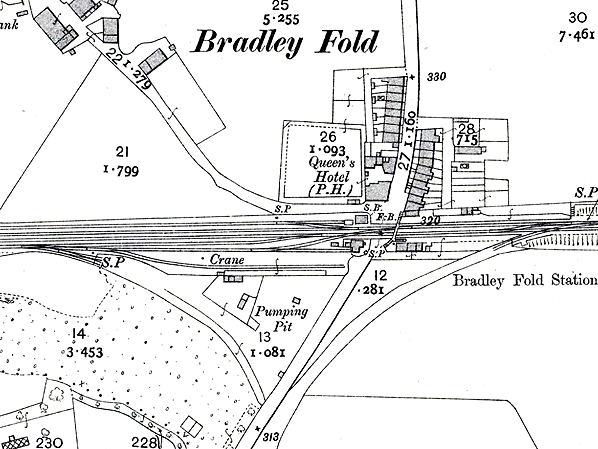
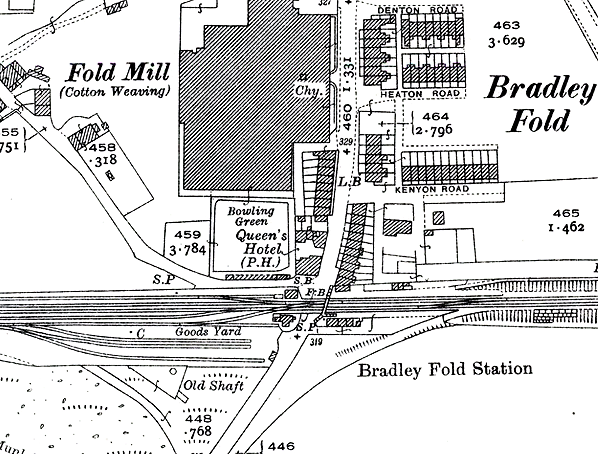
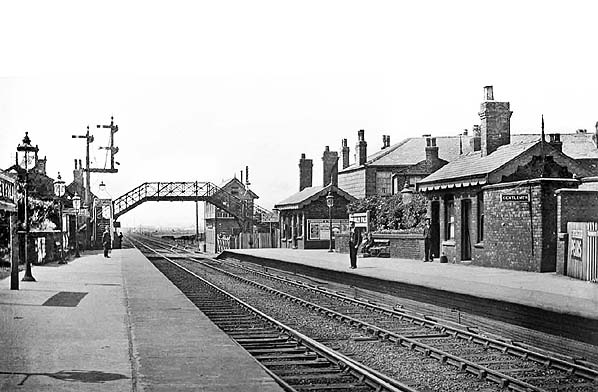 Another view looking west from the down platform but this time in the second decade of the 20th century. Beyond the footbridge to the right of the line the 1907 LYR Size 8 signal box can be seen. It replaced the original box of 1872. The photo is taken from a point further to the east and both up platform buildings can be seen. The building closest to the level crossing on the up side (right) probably dated from 1848 as it is shown on the 1850 6-inch scale map.
Another view looking west from the down platform but this time in the second decade of the 20th century. Beyond the footbridge to the right of the line the 1907 LYR Size 8 signal box can be seen. It replaced the original box of 1872. The photo is taken from a point further to the east and both up platform buildings can be seen. The building closest to the level crossing on the up side (right) probably dated from 1848 as it is shown on the 1850 6-inch scale map.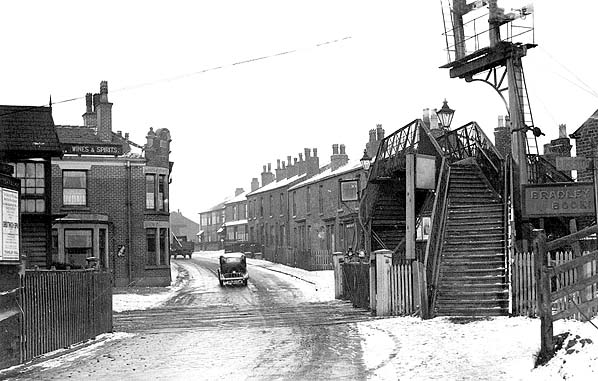
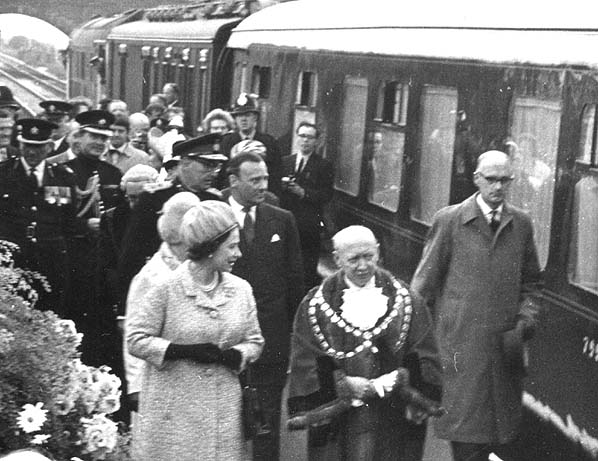


 On 1 December 1879 a junction was formed 1 mile to the east of the station. Called Bradley Fold Junction it was created when the LYR opened a line from Manchester to this point via Prestwich and Radcliffe. The line had opened in stages with the section between Radcliffe South Junction and Bradley Fold Junction being the last to open (click
On 1 December 1879 a junction was formed 1 mile to the east of the station. Called Bradley Fold Junction it was created when the LYR opened a line from Manchester to this point via Prestwich and Radcliffe. The line had opened in stages with the section between Radcliffe South Junction and Bradley Fold Junction being the last to open (click  From February 1916 the direct services to Manchester Victoria ceased and in their place a rail-motor service was introduced. It ran between Bolton Trinity Street and Radcliffe. The alteration was brought about following electrification of the Bury Bolton Street to Manchester Victoria via Radcliffe and Prestwich route. A high frequency service of electric trains was operated on that line giving Bradley Fold passengers who wanted to travel via that route the option of a quick change of trains at Radcliffe.
From February 1916 the direct services to Manchester Victoria ceased and in their place a rail-motor service was introduced. It ran between Bolton Trinity Street and Radcliffe. The alteration was brought about following electrification of the Bury Bolton Street to Manchester Victoria via Radcliffe and Prestwich route. A high frequency service of electric trains was operated on that line giving Bradley Fold passengers who wanted to travel via that route the option of a quick change of trains at Radcliffe. 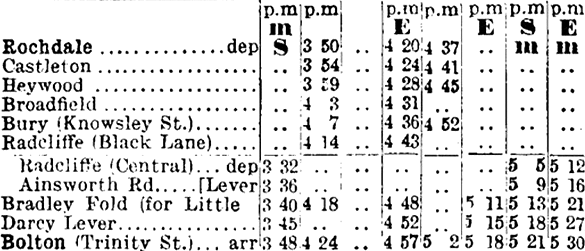
 The summer 1967 timetable showed 23 up departures on Monday-to-Friday and 26 on Saturday; Sunday services operated between 18 June and 17 September only and 11 departures were provided. In the opposite direction there were 23 Monday-to-Friday departures, 28 on Saturday and 12 on Sunday. Destinations, in addition to Rochdale and Bolton Trinity Street, were Bury Bolton Street, Blackpool (North and South), Wigan Wallgate, Liverpool Exchange and Southport.
The summer 1967 timetable showed 23 up departures on Monday-to-Friday and 26 on Saturday; Sunday services operated between 18 June and 17 September only and 11 departures were provided. In the opposite direction there were 23 Monday-to-Friday departures, 28 on Saturday and 12 on Sunday. Destinations, in addition to Rochdale and Bolton Trinity Street, were Bury Bolton Street, Blackpool (North and South), Wigan Wallgate, Liverpool Exchange and Southport.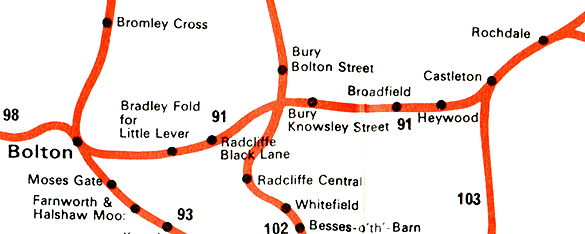
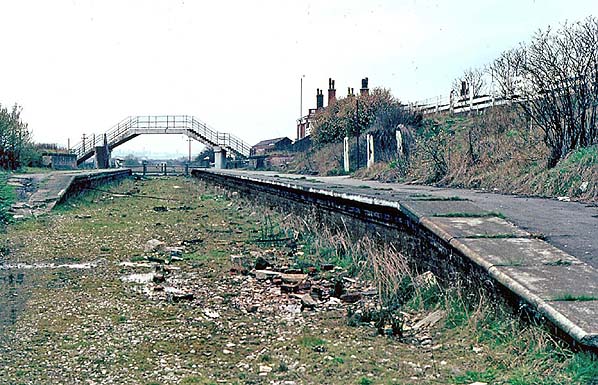
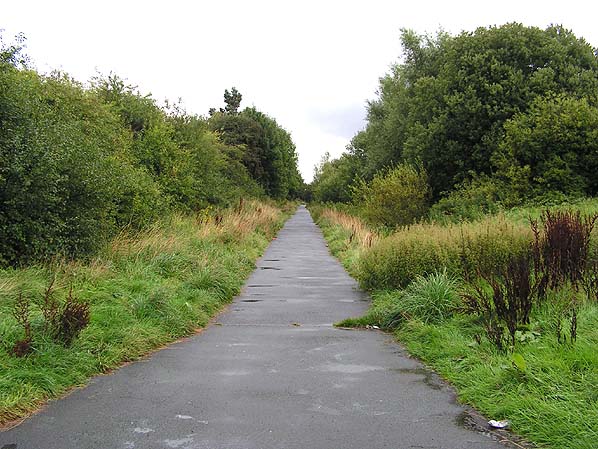

 Home Page
Home Page